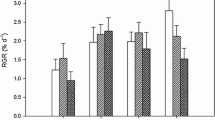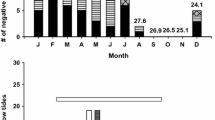Abstract
The effect of tidal emersion on survivorship, photosynthesis and embryonic development was studied in 8 h old zygotes and 7 d old embryos of the intertidal brown alga Pelvetia fastigiata (J. Ag.) DeToni. Zygotes and embryos were outplanted for single low tides in the intertidal zone on the central coast of California (U.S.A.) during June, 1990. Both zygotes and embryos exhibited close to 100% survival when outplanted beneath the canopy of adult P. fastigiata. Embryos (7 d old) also exhibited high survival when outplanted in a red algal turf, the microhabitat where most successful recruitment occurs. However, zygotes (8 h old) experienced high mortality (65–90%) when outplanted in the turf microhabitat. Embryos and zygotes that survived emersion experienced sub-lethal stress that temporarily impaired light-saturated photosynthesis when plants were reimmersed in seawater. The effects of sub-lethal stress were more pronounced in 8 h old zygotes than 7 d embryos, and more severe in the turf microhabitat than beneath the adult Pelvetia canopy. Zygotes outplanted in the red algal turf did not re-establish net photosynthesis until at least 6 h after re-immersion. Photosynthesis was less inhibited in 8 h old zygotes outplanted beneath the adult Pelvetia canopy, and recovered to control (non-emersed) levels within 3 h of re-immersion. Embryos (7 d old) were able to achieve positive net photosynthesis immediately on re-immersion after emersion in the turf or canopy microhabitats. Emersion also retarded the rate of embryonic development in 8 h old zygotes, delaying the formation of primary rhizoids, which help to attach the plant to the substrate. For example, at 19 h post-fertilization, 75% of control (non-emersed) zygotes had developed rhizoids, compared to 3% and 30% for zygotes outplanted in the turf and canopy microhabitats. The different emersion responses of 8 h old zygotes and 7 d old embryos appeared to be related to their ability to tolerate cellular dehydration. Overall, our data suggest that the effects of sub-lethal stresses may have been underestimated in studies of intertidal ecology.
Similar content being viewed by others
References
Abbott IA, Hollenberg GJ (1976) Marine Algae of California. Stanford University Press, Stanford. pp 827
Amsler CD, Neushul M (1991) Photosynthetic physiology and chemical composition of spores of the kelps Macrocystis pyrifera, Laminaria farlowii, and Pterogophora californica (Phaeophyceae) J Phycol 27:26–34
Bird CJ, McLachlan J (1974) Cold-hardiness of zygotes and embryos of Fucus (Phaeophceae. Fucales). Phycologia 13:215–225
Brawley SH, Johnson LE (1991) Survival of fucoid embryos in the intertidal zone depends upon developmental stage and microhabitat. J Phycol 27:179–186
Brawley SH, Johnson LE (1992) Gametogenesis, gametes and zygotes: Ecological perspectives on sexual reproduction in the Algae. Br Phycol J 27:233–252
Chapman ARO (1986) Population and community ecology in seaweeds. Ad Mar Res 23:1–161
Day RW, Quinn GP (1989) Comparisons of treatments after an analysis of variance in ecology. Ecol Monogr 59:433–463
Dring MJ, Brown FA (1982) Photosynthesis of intertidal brown algae during and after periods of emersion: a renewed search for physiological causes of zonation. Mar Ecol Prog Ser 8:301–308
Dudgeon SR, Davison IR, Vadas RL (1989) Effect of freezing on photosynthesis of intertidal algae: relative tolerance of Chondrus crispus and Mastocarpus stellatus. Mar Biol 101:107–114
Dudgeon SR, Davison IR, Vadas RL (1990) Freezing tolerance in the intertidal red algae Chondrus crispus and Mastocarpus stellatus: relative importance of acclimation and adaptation. Mar Biol 107:427–436
Duncan MJ, Harrison PJ (1982) Comparison of solvents for extracting chlorophylls from marine macrophytes. Bot Marina 25:445–447
Flecher RL, Callow ME (1992) The settlement, attachment and establishment of marine algal spores. Br Phycol J 27:303–329
Gerard VA (1990) Ecotypic differentiation in the kelp Laminaria saccharina: phase-specific adaptation in a complex life cycle. Mar Biol 105:337–344
Jaffe LF (1954) Stimulation of the discharge of gametangia from a brown alga by a change from light to darkness. Nature 174:743–744
Keough MJ, Downes BJ (1982) Recruitment of marine invertebrates: the role of active larval choices and early mortality. Oecologia 54:348–352
Kropf DL (1992) Establishment and expression of cellular polarity in fucoid zygotes. Microbiol Rev 56:316–339
Madsen TV, Maberly SC (1990) A comparison of air and water as environments for photosynthesis by the intertidal alga Fucus spiralis (Phaeophyta). J Phycol 26:24–30
Norton TA (1983) The resistance to dislodgement of Sargassum muticum germlings under defined hydrodynamic conditions. J Mar Biol Assoc UK 63:181–193
Oates BR, Murray SN (1983) Photosynthesis, dark respiration and desiccation resistance of the intertidal seaweeds Hesperophycus harveyanus and Pelvetia fastigiata F. gracilis. J Phycol 19:371–380
Pearson GA, Davison IR (1993) Freezing rate and duration determine the physiological response of intertidal fucoids to freezing. Mar Biol 115:353–362
Quatrano RS (1968) Rhizoid formation in Fucus zygotes: dependence on protein and ribonucleic acid synthesis. Science 162:468–470
Reed DC, Amsler CD, Ebbling AW (1992) Dispersal in kelps: factors affecting spore swimming and competency. Ecology 73:1577–1585
Seely GR, Duncan MJ, Vidaver WE (1972) Preparative and analytical extraction of pigments from brown algae with dimethyl sulfoxide. Mar Biol 12:184–188
Smith CM, Kazuhiko S, Fork DC (1986) The effects of osmotic tissue dehydration and air drying on morphology and energy transfer in two species of Porphyra. Plant Physiol 80:843–847
Underwood AJ, Denley E (1984) Paradigms, explanations, and generalizations in models for the structure of intertidal communities in rocky shores. In: Strong D, Simberloff D, Abele L, Thistle A (eds) Ecological communities: conceptual issues and the evidence. Princeton University Press, Princeton, pp 151–180
Vadas RL, Wright WA Miller SL (1990) Recruitment of Ascophyllum nodosum: wave action as a source of mortality. Mar Ecol Prog Ser 61:263–272
Vadas RL, Johnson S, Norton TA (1992) Recruitment and mortality of early post-settlement stages of benthic algae. Br Phycol J 27:331–351
Wright PJ, Reed RH (1990) Effects of osmotic stress on gamete size, rhizoid initiation and germling growth in fucoid algae. Br Phycol J 25:149–155
Author information
Authors and Affiliations
Rights and permissions
About this article
Cite this article
Davison, I.R., Johnson, L.E. & Brawley, S.H. Sublethal stress in the intertidal zone: tidal emersion inhibits photosynthesis and retards development in embryos of the brown alga Pelvetia fastigiata . Oecologia 96, 483–492 (1993). https://doi.org/10.1007/BF00320505
Received:
Accepted:
Issue Date:
DOI: https://doi.org/10.1007/BF00320505




